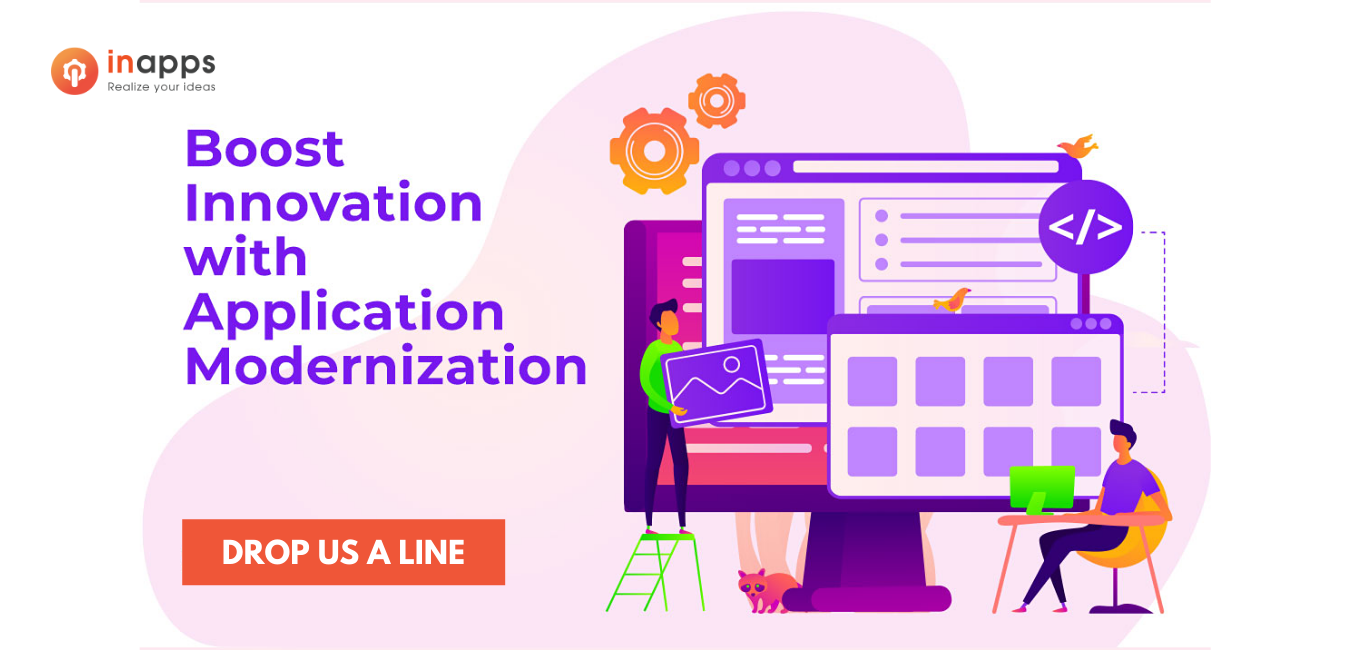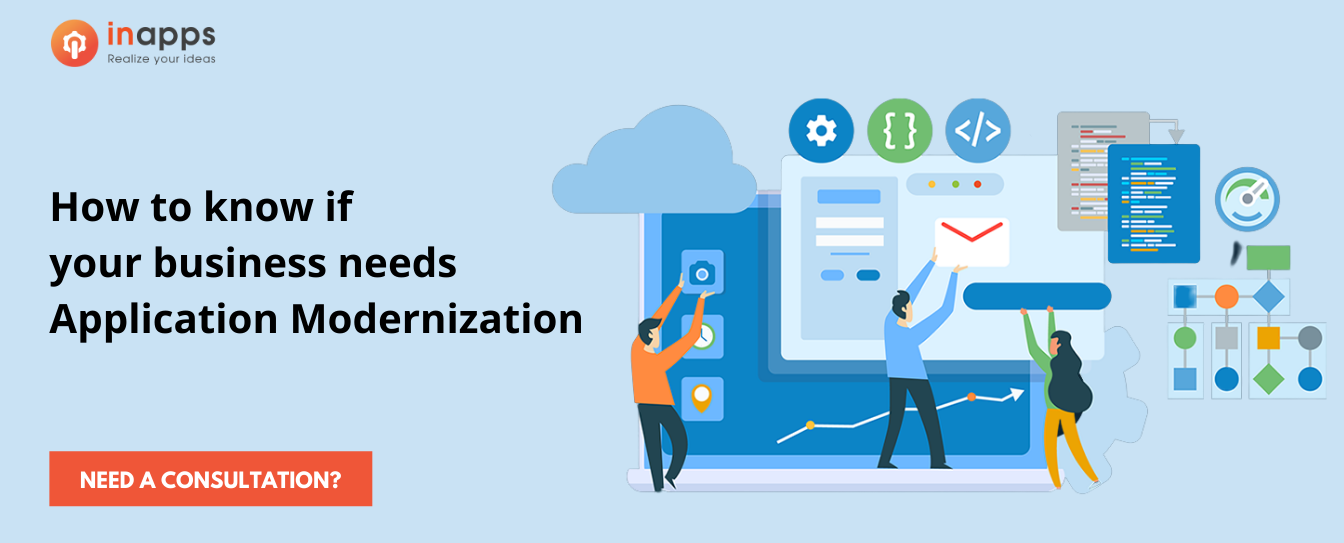It’s no surprise that the market for application modernization services is expected to grow from $11.4 billion in 2020 to $24.8 billion by 2025. If you’re a business owner, then application modernization is an important topic that needs your attention.
Businesses around the world are struggling to keep up with technology. Application modernization can be tricky, but you don’t have to do it alone! In this article, we’ll explore why you might want to go through with an application modernization project, how to know if your business needs one, and finally, what steps you should take.
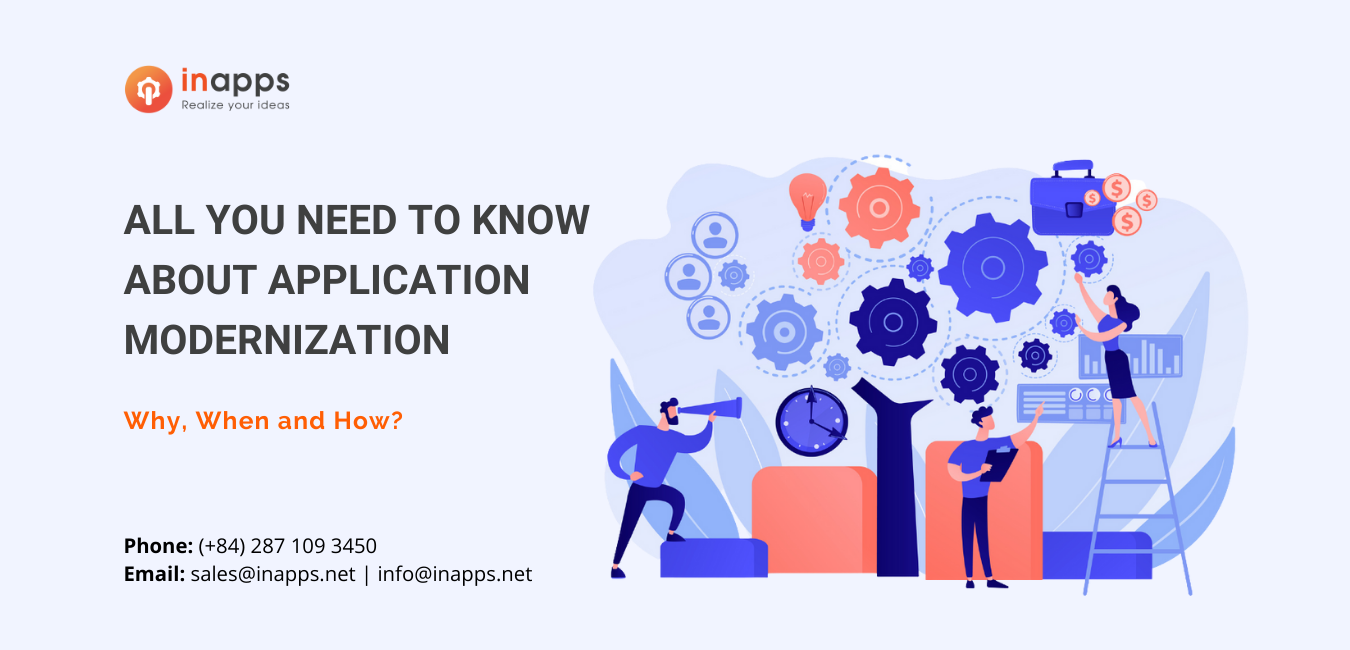
What is App Modernization?
App modernization aims to seamlessly integrate your company’s existing mobile applications into the new digital world. Application modernization is a high-stakes activity that’s most often performed in the following scenarios: growing security risks, legacy applications are too expensive to maintain, and application isn’t scalable for future growth.
Most businesses believe that application modernization is only for large enterprises that rely on outdated legacy systems. However, this is a false assumption.
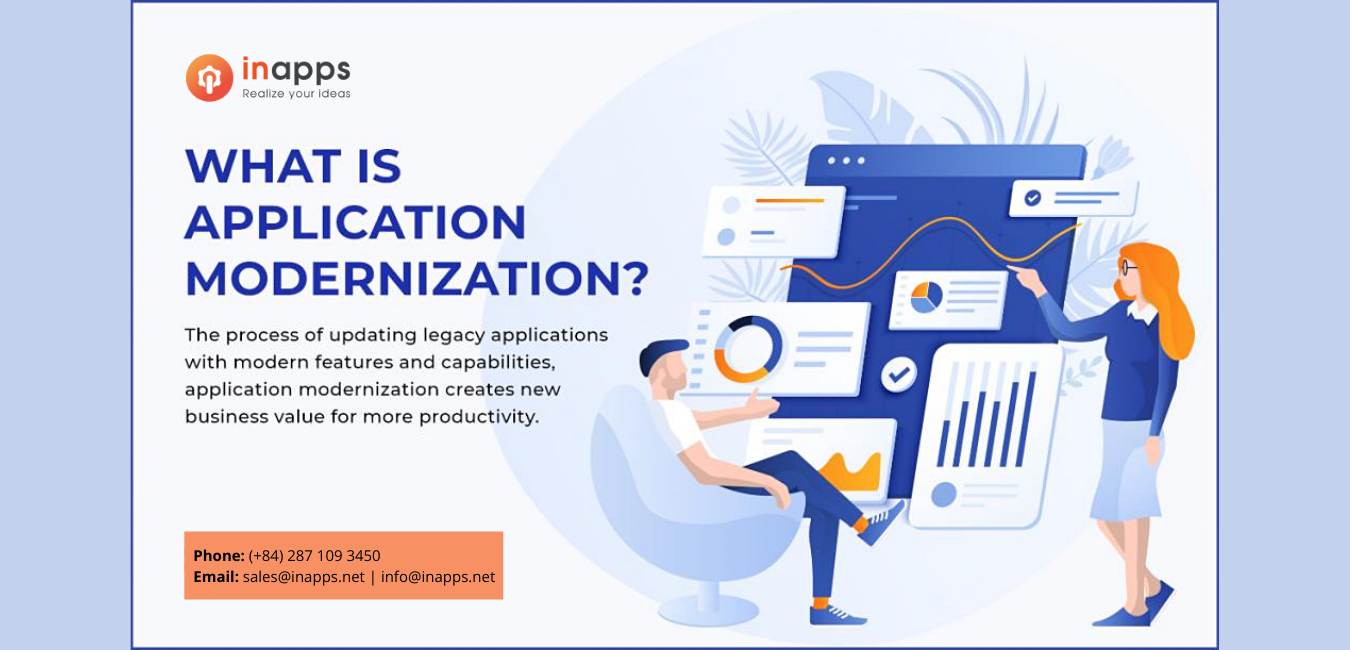
Application modernization is the process of repurposing, refactoring, or consolidating existing business applications better to align them with current business needs and market competition. A legacy app can be modernized by migrating it to a newer, more advanced platform, updating its technology stack, improving its application architecture, or simply adding cutting-edge features with edge technologies.
It’s no surprise that even recently launched enterprise systems aim for digital transformation by evolving into next-generation applications or enhancing customer/business-centric applications/processes to AI/VR.
Businesses need to take a step back and consider their options carefully before making any decisions about how they want their applications delivered in the future.
Why go for Application Modernization?
For the past few years, digital transformation has been a buzzword. On the other hand, the pandemic increased its use as most businesses realized the importance of being digitally present to cater to the needs of digitally conscious customers while physically distancing themselves.
However, the monolithic architecture on which legacy applications ran posed a significant challenge to organizations attempting to achieve digital transformation. In a world where business applications were flourishing in Low-Code/No-Code environments, these apps were still running on dying technologies.
While newer applications communicated with other applications using microservices and APIs, legacy applications still required entire development teams for even the most minor third-party integration. It’s no surprise that businesses needed an upgrade. This is precisely what application modernization provided.
Application modernization provided state-of-the-art tools and technologies to an organization’s legacy systems. They could realize the full potential of their systems and processes to provide a better experience and functionalities to system participants.
Without application, digital transformation is meaningless. Modernization is analogous to attempting to relocate to a new country but lacking the desire to travel. To fully transform your business into the digital landscape, you must modernize your systems, processes, and products.
There may be several reasons why you choose to modernize your application. Some of these are listed below:
Enhanced Security:
Systems running on obsolete technologies or dying platforms can pose a security risk to the data fed into them. In older platforms, security patches become more vulnerable. Application modernization eliminates this challenge and improves security by upgrading to the most recent platforms or technology versions.
Scalability With Cloud:
When modernizing an app, the systems are typically migrated to the Cloud. While physical servers limit the application’s ability to scale, running the application architecture on the Cloud provides greater scalability and increased security.
Increased Opportunity to Automate:
As a result of the pandemic-induced lockdowns, many businesses are automating. Businesses with modernized applications have a better chance of automating their applications that have already been migrated to the Cloud.
Prevent Being Outdated & Outcompeted:
Many businesses fail because they provide their users and customers with an outdated system. This could lead to the business getting out-competed. A modernized application keeps you up to date and provides cutting-edge functionality.
Reduced Manual Dependency:
Application modernization refers to systems designed to automate most tasks and eliminate redundancy or repetitiveness. This reduces the workforce’s reliance on them and allows them to be more productive at work.
The right time to consider Application Modernization
Is modernization right for your business? Whether your business is constantly growing or stagnant, you will require software modernization at some point. If you can check off any of the following boxes, it’s time to consider app modernization.
1. You want to save money on maintenance and operations.
Legacy products frequently cost more to maintain due to the hardware/infrastructure they run, the need for better architecture, a lack of reusability, and technical debt.
You can improve efficiencies and lower operational and maintenance costs by opting for application modernization using the most up-to-date tools and technology. Many people decide to outsource their entire enterprise application development to an outsourcing company to rebuild the system. This contributes to even lower development costs.
2. You desire easier integration
Your current legacy products were most likely not designed for modern integrations. Web-enabled APIs enable your product to integrate with other software service providers seamlessly. Most legacy products lack this API, making the company less appealing to prospective customers.
Replatforming your existing legacy products and leveraging the open ecosystem can help you build new channel partners, accelerate implementations, and lower the cost of your products for your customers.
3. You want to leverage Cloud
Enterprise Application modernization is about more than just software; it is also about hardware. This is especially true if your customers are sick of maintaining legacy hardware and are eager to migrate to the Cloud, even if your business app isn’t!
Moving to the Cloud isn’t a simple ‘lift and shift’ procedure. To fully benefit from cloud services such as scalability, lower-cost storage options, and elastic infrastructure, you must redesign the platform for complex multi-layered architecture.
Application Modernization approach
There are 3Rs to be aware of when attempting to modernize an application. These are the three approaches that most companies use to modernize their legacy systems. Let’s find out more about them as follows.
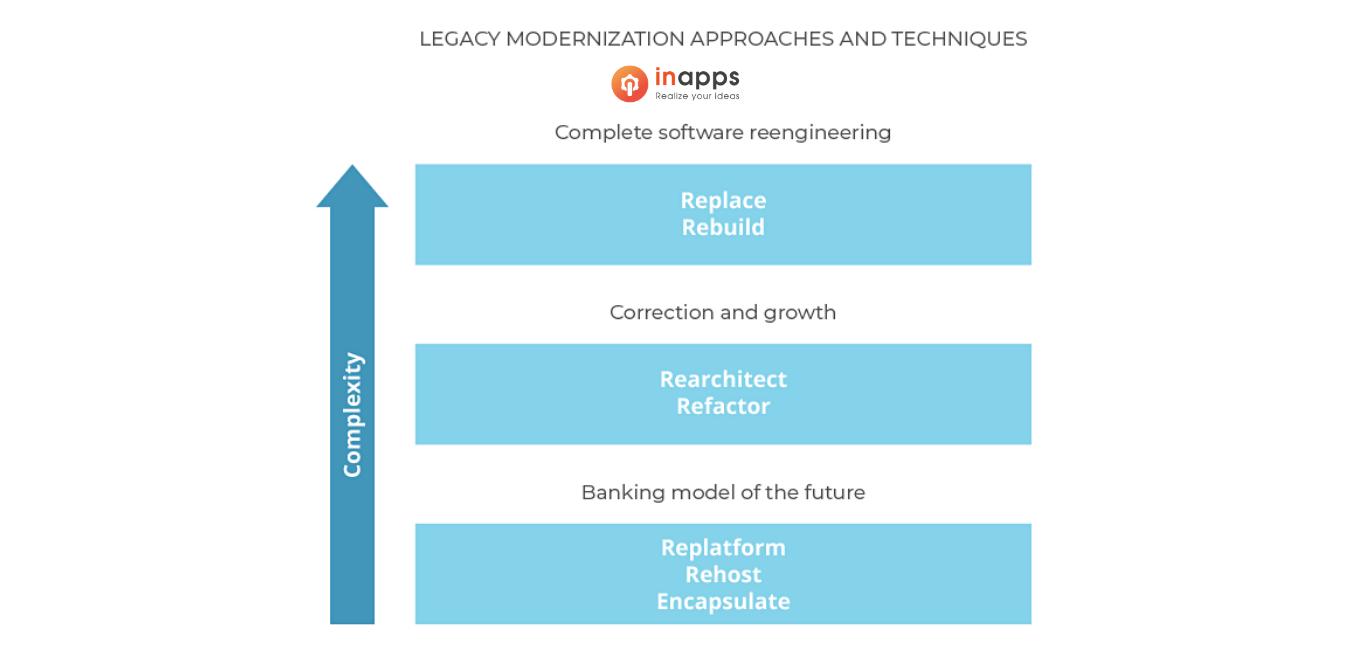
Approach #1: Re-hosting
This is the stage at which the application is lifted and moved to another hosting service. Businesses can migrate their applications to the Cloud without affecting the stack. There has been no specific change or addition of functionality to the application. The only thing needed is a cloud migration partner to move the application to various Cloud hosting providers such as Amazon AWS, Microsoft Azure, or Google Cloud.
In addition to re-hosting, many companies use the Cloud’s benefits to make their applications more robust and dynamic in today’s digital environment. We call it application re-platforming. You not only lift and shift to the Cloud, but you also make minor changes to the application to incorporate new cloud capabilities.
Approach #2: Refactoring
Refactoring is the following method that many businesses use to modernize their applications. This means that businesses hire a team of application modernization service providers with an entire development team to modify the existing application. This app has been modified to make it more suitable for use in a cloud environment.
Approach #3: Rebuilding
This is the stage at which developers rebuild the entire application. The application’s code is rewritten, and the older application is stacked. We build a new application from scratch with newly written code and are ready for the new cloud environment. New functionalities are added, features are introduced, processes are optimized, and various other missing elements are added to the application to make it more dynamic and, in some cases, cloud-native.
Modernize Legacy Applications: A step-by-step guide
When it comes to legacy application modernization, there are several steps to consider. These begin with understanding and analyzing the existing system, its technology stack, dependencies, and so on before identifying opportunities for modernization. The path from planning to actual modernization of a legacy application includes several steps, which we will discuss below.
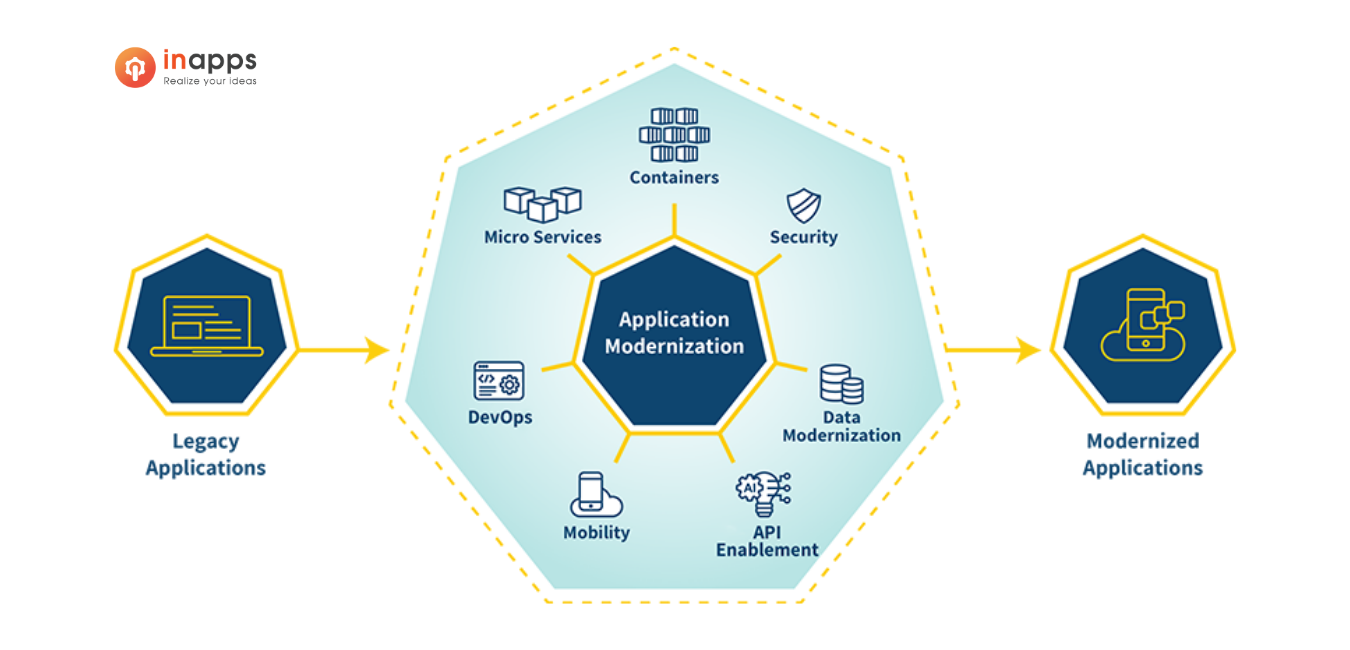
Step 1: Recognize, Identify, and Assess
Begin by comprehending the current application technology stack and conducting an analysis of the current state architecture.
This is a critical evaluation because you must identify and comprehend dependencies (data, interfaces), complexity, and unused or missing code.
Also, try to comprehend your operations’ and infrastructure’s security and performance requirements. This is the stage at which you will assess the impact on end-users to mitigate any risks associated with implementing modernization.
Step 2: Make a plan
Create a modernization roadmap that includes estimates, a technical approach, risk mitigation, governance, integration requirements, a testing strategy, and security. This will be a detailed roadmap from which you will derive information, such as the project plan, costing details, and staffing requirements.
Step 3: Implementation
Critical elements of your implementation will include design, build, test, and deployment. You will need an agile framework for the best results, and you should begin leveraging DevOps best practices. Furthermore, take data migration seriously and make sure that your existing data is transformed and cleansed during migration in addition to designing new structures.
Step 4: Go-Live
Going Live is by far the most exciting part of the journey, and no matter which approach you take, it is a significant milestone in your process.
Ensure that process-related communication is not limited to a small group of people within the organization. It reaches out to the more extensive network that uses the system. Remember that the ultimate test for the success of your application modernization is end-user acceptance.
Step 5: Maintain
You’ve completed the most recent phase of modernization and are now live. The next obvious question is who will take responsibility for maintaining the new application. What kind of skills are you looking for, and how long will you require assistance after going live?
After you’ve answered these questions, the maintenance process can begin in earnest. Knowledge transfer to the maintenance team should be an ongoing process, with all post-modernization practices should be documented. Finally, remember to decommission legacy systems to save money.
Wrapping Up
Today, most industries rely on technological advances such as business intelligence, analytics, and machine learning to perform business processes efficiently and consistently deliver optimal results.
However, not all of them use business applications in their daily operations. Given the sensitive nature of data and cybersecurity concerns, specific industries such as healthcare, banking, and financial services, IT, travel and hospitality, and even e-governance require application modernization regularly. One can hire AI engineers, add blockchain functionality, or even hire data scientists to incorporate the power of these cutting-edge technologies into their existing systems.
Application Modernization service providers
In today’s competitive and dynamic business landscape, quick response to opportunities and challenges, an exceptional user experience, and streamlined processes are absolute necessities for a company to run smoothly.
Legacy products and processes are frequently time-consuming, costly, and incapable of meeting modern business KPIs. On the other hand, application modernization uses the power of new IT architectures to make legacy applications’ functionalities more relevant and contemporary while improving agility, efficiency, and customer experience.
InApps Technology is one of the best app outsourcing companies in Vietnam and in the world ranked by Clutch, The Manifest, GoodFirms, SoftwareWorld,… and many other trusted sources.
We are a leading legacy application modernization company that helps our customers with business transformation by assisting them in transitioning from legacy to cloud in a smooth, quick, and efficient manner. We have skilled and experienced engineers who assist in developing futuristic and cohesive strategies for creating and executing customized application modernization roadmaps.
[sociallocker id=”2721″]
List of Keywords users find our article on Google:
| application modernization roadmap |
| app modernization |
| application modernization |
| what is app modernization |
| application modernization steps |
| application modernization approach |
| application modernization companies |
| what is application modernization |
| technology modernization providers |
| application modernization technology |
| application modernization services |
| application modernization icon |
| business application modernization |
| application modernization process |
| application modernisation services |
| application modernization definition |
| application modernization best practices |
| modernizing your applications |
| ruby application modernization |
| ruby app modernization |
| web application modernization |
| modernize applications and operations |
| application modernization service |
| application modernization for dummies |
| product modernization services |
| what is application modernisation |
| inapps technology |
| application modernization framework |
| app modernisation |
| application modernisation |
| application modernization patterns |
| modernizing your business applications |
[/sociallocker]
Let’s create the next big thing together!
Coming together is a beginning. Keeping together is progress. Working together is success.




